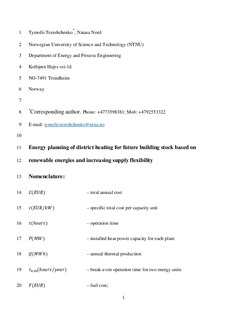| dc.contributor.author | Tereshchenko, Tymofii | |
| dc.contributor.author | Nord, Natasa | |
| dc.date.accessioned | 2019-01-21T09:39:51Z | |
| dc.date.available | 2019-01-21T09:39:51Z | |
| dc.date.created | 2016-10-07T15:50:15Z | |
| dc.date.issued | 2016 | |
| dc.identifier.citation | Energy. 2016, 112 1227-1244. | nb_NO |
| dc.identifier.issn | 0360-5442 | |
| dc.identifier.uri | http://hdl.handle.net/11250/2581419 | |
| dc.description.abstract | This paper discusses factors associated with the decisions on energy supply plants in new or existing district heating (DH) systems. Three highly efficient energy conversion technologies were considered. The study focused on an assessment of the heat supply units, considering the economic aspects and technical limitation of the technologies. Further, risks associated with the changes in heat load profiles and fuel price volatility were investigated. The existing method for heat supply optimization was compared with a new method, suggested in this paper. The new method was based on detailed performance simulation models developed in Aspen HYSYS software and data post-processing in MATLAB. The results showed that the existing method for the heat supply optimization cannot demonstrate all the advantages of highly efficient conversion technologies. The study on the new method examined 36 plant combinations and identified eight with a levelized cost of energy (LCOE) under 0.15 EUR/kWh. The results showed that an increase in the flexibility of DH provided better heat supply reliability, while increasing the heat cost. The total deviation in LCOE due to fuel and electricity price volatility was in the range of 1.6%–3.6%. Further, a change of 20% in the plant investment costs induced almost the same variation in LCOE. | nb_NO |
| dc.language.iso | eng | nb_NO |
| dc.publisher | Elsevier | nb_NO |
| dc.rights | Attribution-NonCommercial-NoDerivatives 4.0 Internasjonal | * |
| dc.rights.uri | http://creativecommons.org/licenses/by-nc-nd/4.0/deed.no | * |
| dc.title | Energy planning of district heating for future building stock based on renewable energies and increasing supply flexibility | nb_NO |
| dc.type | Journal article | nb_NO |
| dc.type | Peer reviewed | nb_NO |
| dc.description.version | acceptedVersion | nb_NO |
| dc.source.pagenumber | 1227-1244 | nb_NO |
| dc.source.volume | 112 | nb_NO |
| dc.source.journal | Energy | nb_NO |
| dc.identifier.doi | 10.1016/j.energy.2016.04.114 | |
| dc.identifier.cristin | 1390263 | |
| dc.description.localcode | © 2016. This is the authors’ accepted and refereed manuscript to the article. This manuscript version is made available under the CC-BY-NC-ND 4.0 license http://creativecommons.org/licenses/by-nc-nd/4.0/ | nb_NO |
| cristin.unitcode | 194,64,25,0 | |
| cristin.unitname | Institutt for energi- og prosessteknikk | |
| cristin.ispublished | true | |
| cristin.fulltext | postprint | |
| cristin.qualitycode | 2 | |

